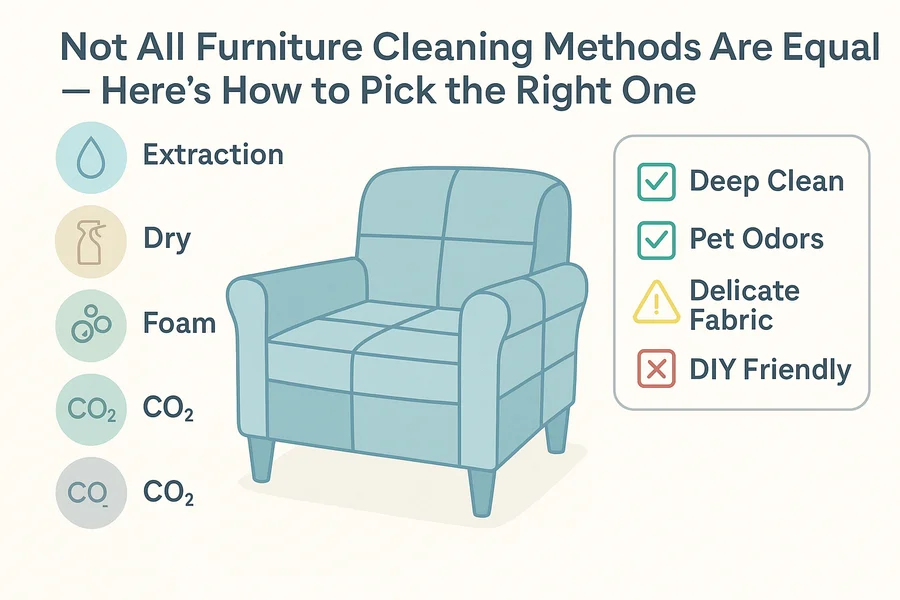Not All Furniture Cleaning Methods Are Equal — Here’s How to Pick the Right One

Choosing the right method for upholstery cleaning depends on your furniture fabric, the level of dirt, the presence of stains or odors, and whether you have pets or allergies. Below is a comprehensive comparison of the most common upholstery cleaning methods used in the U.S.
Upholstery Cleaning Methods Comparison Table
| Method | Deep Cleaning | Fast Drying | Safe for Delicate Fabrics | Odor Removal | Pet Stain Removal | DIY-Friendly |
|---|---|---|---|---|---|---|
| Extraction Cleaning | ✅ | ❌ | ⚠️ | ✅ | ✅ | ⚠️ |
| Dry Cleaning | ⚠️ | ✅ | ✅ | ⚠️ | ❌ | ✅ |
| Foam Cleaning | ⚠️ | ⚠️ | ✅ | ⚠️ | ⚠️ | ✅ |
| Encapsulation | ✅ | ✅ | ⚠️ | ❌ | ❌ | ❌ |
| CO₂ Cleaning | ✅ | ✅ | ✅ | ✅ | ⚠️ | ❌ |
Legend:
- ✅ – Excellent
- ⚠️ – Moderate or depends on technician/product
- ❌ – Not recommended or not effective
How to Choose the Best Cleaning Method
Consider Your Fabric Type:
- Delicate fabrics like silk or linen are better suited for dry or foam cleaning.
- Durable materials like polyester, microfiber, or cotton blends work well with extraction or encapsulation.
Consider the Type of Dirt:
- For deep stains and odors, extraction or CO₂ cleaning is more effective.
- For surface dirt, encapsulation or dry cleaning may suffice.
For Pet Owners:
- Choose extraction cleaning to deal with urine stains and odors.
- Avoid dry or encapsulation methods for biological contaminants.
For Allergy Sufferers:
- Use hypoallergenic extraction methods with rinsing agents.
- Avoid heavily scented or solvent-based products.
Professional vs DIY Cleaning
| Criteria | Professional Service | DIY Cleaning |
|---|---|---|
| Equipment Power | ✅ Industrial-grade | ⚠️ Limited |
| Stain Removal | ✅ High success rate | ⚠️ Varies |
| Risk of Damage | ✅ Low (trained techs) | ⚠️ Higher |
| Time Investment | ✅ Fast | ❌ Time-consuming |
| Cost | ⚠️ Higher upfront | ✅ Budget-friendly |
Fabric Type Compatibility
| Fabric Type | Recommended Method |
|---|---|
| Microfiber | Extraction, Foam |
| Velvet | Dry Cleaning, Foam |
| Cotton | Extraction |
| Linen | Dry or Foam Cleaning |
| Leather | Specialized Leather Treatment |
| Synthetic Blends | Extraction, Encapsulation |
FAQ
Q: Can I clean my microfiber couch with water?
A: Yes, but use minimal water and preferably an extraction machine. Too much water can leave stains.
Q: Does dry cleaning remove pet urine odor?
A: Not effectively. Odors require enzymatic treatment or extraction with rinsing.
Q: How long does it take to dry after extraction?
A: Typically 2–6 hours, depending on airflow and humidity.
Q: Is encapsulation safe for home furniture?
A: It’s more often used in commercial settings. Not ideal for residential sofas with deep cushions.
Final Thoughts
Each cleaning method has its strengths and limitations. For general use, extraction cleaning remains the most versatile and effective option, especially for families with kids or pets. For delicate or antique furniture, always consult a professional to avoid damage.
Need help deciding which method is right for your sofa or chair? Our team offers free quotes and expert advice. Contact us today!
